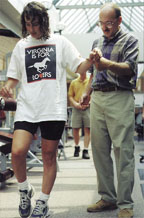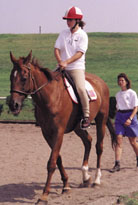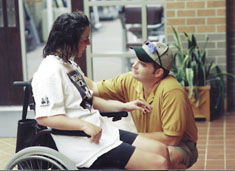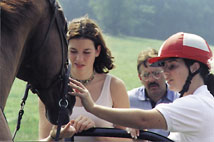Riding on wings and prayers:
Because of folks at Tech equine center she calls angels, disabled equestrian rides again
by Su Clauson-Wicker

|
At 24, Fiona Larsen has every excuse to sit around doing nothing for the rest of her life.
Four years ago, upon being thrown from a thoroughbred at the Charles Town Race Track, Larsen suffered a traumatic brain injury and spent six months in a coma. She lost most control over her limbs, developed double vision, and spoke with slow, slurred speech. Some said she would never walk again, let alone ride a horse.
But Larsen is not still sitting idly in her wheelchair, largely due to the efforts of a group of Virginia Tech employees at the Marion duPont Scott Equine Medical Center (EMC). |
|
Virginia Tech Equine Center administrator Richard Gargagliano is Larsen's "angel," she says.
|
|
Not long after a desperate caseworker parked Larsen's wheelchair by EMC's admissions window, hoping that seeing the horses would rekindle the young woman's interest in life, Larsen revealed to EMC administrator Richard Gargagliano that she harbors two seemingly impossible goals--she wants to be an internationally competitive rider, and she aspires to attend Virginia Tech.
"Why not?" the father of two young equestrians asked himself. "Whatever she achieves can only help her gain independence in the long run." An army of people, led by Gargagliano, is helping Larsen take steps to reach these goals.
Literal steps sometimes. In June, after months of strolling through the hospital corridors braced up by a foal walker, Larsen took seven halting, shaking, unassisted steps at EMC. "Now she has a new goal--eight steps," Gargagliano says. He, Fiona, and her mother, Pat Larsen, a perky mother of nine, outlined an ambitious training program structured around four goals: learning to walk, re-learning to ride competitively, getting a job, and gaining the skills to enter Virginia Tech in 2001. The 24-year-old woman has donated more than 750 volunteer hours doing clerical work in EMC's busy admissions office; the equine center, in turn, has adopted Larsen and enlisted other Leesburg agencies to assist in her quest to compete in the 2000 Paralympics in Sydney, Australia. Larson won several gold medals at the Sept. 11 tryouts and can be counted a serious contender.
Larsen also swims and lifts weights of a magnitude that shames some male clients at Leesburg's Ida Lee Recreation Center. This new strength is paying off in her stamina and posture during bi-weekly lessons at nearby Loudoun Therapeutic Riding. "This is fun," she says in her characteristically halting voice.
"There's a spark in Fiona that was not damaged. In fact, the accident may have increased her ability to focus and persist," Gargagliano says.
Tech alumna Sherry Perkins Craighill (accounting '79) noticed that spark when she spotted Larsen watching a steeplechase from her wheelchair last year. "Fiona was so beautiful; I could tell she had a bright mind, and it seemed such a tragedy she was trapped in that body," Craighill says.
 |
The Chief Financial Officer of Meadow Farms began taking Larsen out to dinner every month and volunteered to raise funds when she heard about Gargagliano's training project.
"My goal is $25,000," Craighill says. "We thought we had a major sporting goods company ready to sponsor the total program, but they backed out at the last minute. I haven't given up on them."
Larsen's trusted partner in competition training is Killy Beggs,a blood-donor horse at Virginia Tech Equine Center who lost his eye seven years ago. |
Under a $2,500 grant from Virginia Tech's Affirmative Action Incentive Grants Committee, Larsen's progress and the changes in EMC employee's attitudes toward disabled workers will be documented. The proposal, penned by Gargagliano, suggests EMC's project may become a model for other programs with the disabled.
"We are a hospital founded on the generosity of the community--with a $4-million gift from Marion duPont Scott and land from the Westmoreland Foundation. Now we are giving back to the community by helping Fiona," says Dr. Fred Fregin, director of the EMC. "She's inspiring others by letting them know that people with disabilities don't have to sit in the corner."
Larsen has been transformed from the pudgy, taciturn young woman who was wheeled into the business office to watch the horses back in 1996 to a muscular athlete with a sparkle in her eyes. These days she doesn't spend much time in the wheelchair, preferring to use her cane and to maneuver by holding on to walls and furniture. One of the most touching things to come out of Larsen's program is her partnership with Killy Beggs, the hospital's one-eyed, blood-donor horse.
"We didn't know how things would go when we put her up on Killy, but it was amazing. It's like they're each other's missing parts," says Gargagliano.
 |
Larsen began her therapeutic riding program on a pony with attendants hovering on either side. To the former nationally ranked riding champion, this was an indignity. It was bad enough that she couldn't be jumping fences, but to be lumbering along on a pony--Larsen didn't need words to communicate her displeasure. In desperation, Gargagliano tried her on the former race horse.
One of Fiona Larsen's biggest fans is longtimeboyfriend Tom Bourne, who left Tech after her accident. |
"Killy Beggs hadn't been ridden for seven years. The way things worked out was really surprising to me," says Shawn Furr, pharmacy technician, who with her husband, hospital veterinarian Dr. Martin Furr, has been caring for Killy since he was donated to the hospital. "Usually one-eyed horses are skittish, but not Killy," she says. "The first time Fiona rode him, he hesitated with each step, trying to figure out what she wanted. Now they're bonded. It's obvious he's happy."
Killy's owner donated him to the equine center after the horse lost his right eye to an infection. His blood has saved the lives of more than a few equine patients.
When Larsen went to the U.S. Paralympic evaluation camp on New York's Long Island in September, Killy Beggs went with her, accompanied by her volunteer riding instructor, Mary Jo Beckman, and Gargagliano.
"Fiona had an outside chance at best of being one of the six Paralympic team members (out of about 62,000), but this preparation has been a grounding force for her. It's kept her focused. She's come a long way," Gargagliano says.
Celebrations along the way have kept her spirits up. In July, Beckman put Larsen and Killy through the dressage riding test they would repeat at the Paralympic try-outs. To further lock in the dream of being in competition, television producer Bob Cohencious, who's been documenting Larsen's progress, brought in a loud speaker and triumphant brass music to underscore her moves. As at least 25 of her supporters watched, Larsen sat straight in the saddle, head high, in near perfect form.
Sitting erect, keeping her head up--things that most of us take for granted--had required months of arduous strength building exercises for Larsen. After an hour of riding, she dismounted shaking--people with her injury run out of gas fast.
"Tears were rolling out of my eyes when I saw her today," said EMC Director Fregin. "To realize how far she has come and how far she wants to go, you have to acknowledge what a supreme effort she's making."
In a videotape made six months earlier, Larsen slumped like a sack of potatoes in the saddle. Now she looks more like a soldier.
"She's bought the whole program," Gargagliano says."To be the kind of athlete she wants to be takes complete dedication. She's got it. She's more deserving to be a role model than most professional athletes."
The Fiona Larsen project is riding a tidal wave of enthusiasm at the EMC. Facilities manager Steve Hummer dipped into his own pocket to buy her an adult-sized tricycle so that she could practice her dressage moves when not on horseback; the Furrs are keeping Killy Beggs in competition shape; and others stop by to applaud her successes.
"Fiona's got dreams. You see people at the hospital really energized by working with her. They look around at each other and see changes. I think in helping her we can be the person we want to be, but were afraid to be. They discover a co-worker has a heart after all, or they look at Fiona's efforts and realize they need to set higher goals for themselves. Having her here is definitely not a liability," Gargagliano says.
In a facility as busy as the EMC, making time to work with someone with Larsen's disabilities isn't easy, but admissions supervisor Robin Koenen and her staff willingly took on Larsen as a volunteer and now a paid employee. In the beginning, communication was difficult.
"When you're in a hurry, it's hard to listen to Fiona say things several times," Koenen says. "Her speech has really improved since she started. Fiona has really been helpful. Besides doing the clerical tasks we give her, she'll talk to clients about their horses if we're busy."
"Admissions is our nerve center," Gargagliano says. "Clients come in with emergencies. Fiona is one of the first smiling faces they see. She has the ability to take people who might not be having a good day and get them to think differently about their lot." 
Gargagliano's reasons for spearheading this program can be traced to a plaque at EMC dedicated to members of the 1995 U.S. Pony Club International Games team killed enroute to an international competition. His daughter Laura was in that van, but not one of the three who died or the six who sustained life altering injuries. Gargagliano, seared with the realization that "terrible things don't just happen to other people," felt he needed to take what those equestrian athletes stood for to the living.
"When Fiona showed up, I knew I had to help," he says. "Luckily, I had a boss (in Fregin) that I didn't even have to explain that to."
"We've assembled an army of people who are each willing to take a piece of this and say 'I can help,'" says Gargagliano. "But I think the biggest thing we have given Fiona so far is hope and self esteem."
Larsen puts it a little differently.
"Richard got me started. He's kind of like my angel. Coming to the Equine Center has changed my life. I finally feel alive again."
Some information for this story was contributed by Jeffrey Douglas, APR, information coordinator for the Virginia Maryland Regional College of Veterinary Medicine.
Back to Features Page
Home | News | Features | Research | Philanthropy | President's Message | Athletics | Alumni | Classnotes | Editor's Page




